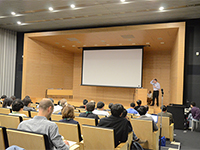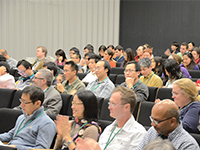

As part of its research area, “The Dynamic Mechanism of and Fundamental Technology for Biological System, ” PRESTO is currently involved in a research project on “Clarification of digit identity determination by quantitative developmental biology” (Representative: Takayuki Suzuki, Assistant Professor, Graduate School of Science, Nagoya University). In line with this research project, a “Live cell imaging” session, jointly organized by JST, was conducted as part of the International Chick Meeting “Chick 7: Avian Model Systems,” at Nagoya University and Hotel Rubura Ohzan over two days, on November 17 and 18. This session was co-chaired by Professor Yoshiko Takahashi (Graduate School of Science, Kyoto University, and representative of a research project in the CREST research area, “Fundamental technologies for medicine concerning the generation and regulation of induced pluripotent stem(iPS) cells”) as well as Assistant Professor Takayuki Suzuki. The meeting concluded on a successful note, with the number of registered attendees totaling 188, the number of oral presentations totaling eight, and the number of poster presentations totaling 93.
As it is possible to observe living embryos from the outside due to the ease of manipulation for chicken embryos, the chicken is one of the best animals that can be used as a model to study organogenesis at the cellular and organ levels. In recent years, research methods that make use of chicken embryos have advanced by leaps and bounds from the classical developmental method which made use of the chimeric embryos of chickens and quails. The advancements have been achieved through the development of methods for producing transgenic chickens, as well as the development of new gene transfer vectors. Such new analytical methods have led to success in capturing the state of living cells in chicken embryos with greater precision than before, and have contributed to uncovering the causes behind genetic diseases such as neurological and immune disorders, as well as to elucidating the mechanisms that have been developed by our bodies over time.
Life cell imaging involves the observation of the state of living cells. For this symposium, organized jointly with JST, a lecture that placed a particular focus on the subject of live cell imaging was conducted, with the aim of promoting the exchange of information as well as discussions. The International Chick Meeting also serves as a space that draws together the largest number of researchers from around the world who use chickens for their research material. By providing these researchers with the opportunity to give presentations, the symposium also aims to generate new scientific knowledge together with the researchers, in areas ranging from genesis to livestock, heredity, and resources. This session was conducted by guest researchers from a wide range of research fields. The four Japanese speakers are engaged in melanoma, PGC, limb bud genesis, and angiogenesis research, while the four speakers from outside Japan are engaged in research relating to the production of new gene transfer vectors, transgenic chickens, analysis of mutant chickens, and early development). Each researcher used a different and unique microscope to conduct their observations, receiving many questions from the attendees. While many research laboratories carry out cell observation using confocal microscopes, it became clear that it might be more suitable to use microscopes that are able to observe a relatively larger area, such as macro confocal microscopes. This is because the research of chicken embryos often calls for the analysis of whole cell populations. The presentation also emphasized the importance of facilities that can be used to manage chickens as resources, such as mutant bodies, in the future. In Japan, the only facility that plays a useful role in the collection and breeding of mutant birds is the Avian Bioscience Research Center of Nagoya University. Management facilities such as these have been in existence in the United States and France for a long time, and this fact puts into sharp relief how far behind Japan is in the development of management facilities. Until now, methods for discovering fluorescent proteins, which involve the use of viruses and electroporation, have been applied when conducting cell observation. However, the effectiveness of applying the proteins that have been discovered through these processes to the future study of chickens that have undergone gene transfer was debated. As described above, there is a need for facilities that can manage these research activities, and the symposium highlighted a strong sense of the need to develop resources in Japan. With regard to PRESTO’s research themes, a presentation was given on motoring intracellular signal transduction at the organization level using chemiluminescence microscopy. This generated much discussion, including issues such as the need for analysis to link differences in signal transduction at the cell level, with differences in format. After the lecture, discussion continued at the opinion exchange session. The symposium was a great success from beginning to conclusion.
At the closing session, a declaration was drawn up on the importance of going beyond the research field, and in particular, of fusing basic research with livestock research going forward. All attendees applauded in a show of agreement on the declaration, bringing the symposium to a close.

JST, an integrated organization of science and technology in Japan, establishes an infrastructure for the entire process from the creation of knowledge to the return to the society. For more information, visit http://www.jst.go.jp/EN/